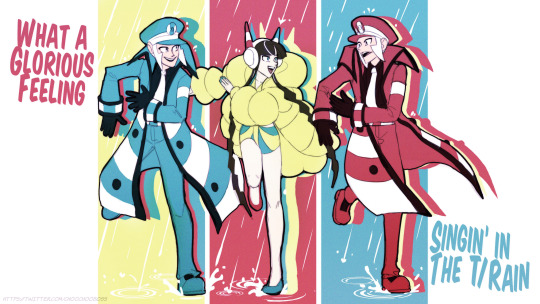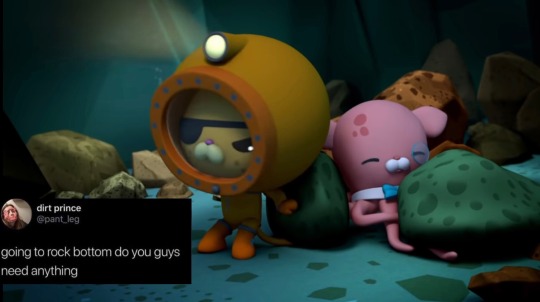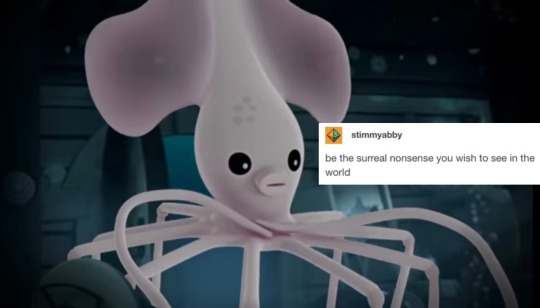#youtube gathering
Text
So uh, if you want to know what Wizards of the Coast is up to, they allegedly sent the Pinkertons (a private security guard, which is a fancy way to say for-hire thugs) to the person who leaked a Magic: The Gathering set. Who wasn't under a NDA or anything (not that it'd justify said measures).
The Pinkertons went to his home, threatened to put him in jail, seized a bunch of his stuff and made his wife cry.
youtube
Anyways, uh, I wonder if there's still gonna be bootlickers trying to defend WOTC on this?
(Reblogs for awareness are appreciated!)
8K notes
·
View notes
Text
Hi! If you like robots and/or Magic: the Gathering, you should come watch this video I made where I am incredibly autistic about robots for 30 minutes!
youtube
#magic the gathering#mtg#myr my beloved#vorthos#i worked ao hard on this i really hope you like it#kiss a robot on the mouth#Youtube
321 notes
·
View notes
Text

Nimbasa trio starring Singin' in the Train at Nimbasa Musical Hall tonight!
Reference video here! (a fun dance scene from Singing in the Rain)
#When the trio gathers together it's always a ton of fun!#I'd love to see these guys could star many classic musicals!#submas#subway bosses#nimbasa trio#subway boss ingo#pokemon ingo#submas ingo#subway boss emmet#pokemon emmet#submas emmet#pokemon elesa#gym leader elesa#Youtube
884 notes
·
View notes
Text
youtube
HEY BABE WAKE UP, THE ENTIRE FUCKING STUDIO ORANGE TRISTAMP OTAKON PANEL JUST DROPPED
#Trigun#Trigun Stampede#Tristamp#I gathered most of this I think#BUT THE ENTIRE THING#I feel so spoiled#Though quite angry I can't watch it rn due to migraine reasons#BUT YOU ALL MUST WATCH AND CELEBRATE IN MY STEAD#Youtube
300 notes
·
View notes
Text






trying out something new
#octonauts#captain barnacles#peso penguin#kwazii#dashi dog#tweak bunny#shellington#professor inkling#octonauts textposts#sorry about the bad quality in some of these#i was foraging around youtube for screenshots like a gatherer#bye now time to disappear for another month kiss kiss
848 notes
·
View notes
Text
Magic the Gathering tip:
youtube
88 notes
·
View notes
Text
when i crack
that secret code
it's sure to lighten my load
#NOTE: im not sure this is actually from the dc show this audio is ripped from willneu97's youtube upload#i just like peter's performance on this version a lot better than the other versions that are on here already.#the mountain goats#tmg#alpha chum gatherer#bootlegs
69 notes
·
View notes
Text
youtube
[Animatic] Jin-Gitaxias in Bloomburrow
He's the king of the junjle.
Feel free to use this image to your hearts' content.

#doodeels#art#myart#fanart#mtg#magic the gathering#animatic#my animatic#my art#phyrexia#phyrexian praetors#bloomburrow#jin-gitaxias#tezzeret#tamiyo#urabrask#sheoldred#vorinclex#skrelv#malcator#elesh norn#Youtube
80 notes
·
View notes
Text
Reserved List
There are over 500 Magic the Gathering cards on the reserved list. This list is a promise to never reprint these cards in paper which means, that for these cards, the copies that exist are the only copies that will ever exist. The reserved list only comprises of sets from before the year 2000 so most reserve list cards are 25 years old minimum. You would think that the cards on the reserve list would all be astronomically high but very few are over a dollar. Many feel that the reserved list will eventually be rescinded but the failure of the 30th anniversary edition cards makes this seem unlikely especially in the modern era. It seems like a lot of money is in newer Magic cards especially with the advent of serialized Magic cards. Now may be the time to move in to bulk Magic the Gathering reserved list cards. Every year the number of reserve list cards in circulation dwindle. Cards get lost or destroyed or they enter vaults never to see circulation ever again due to investors and speculators. At the moment, old school Magic seems to be at an all time low so this might be time to move in to reserve list cards. I recently purchased a couple hundred reserved list cards in various conditions and over the next couple of weeks I will post them online and explain the logic behind my purchase. Am I simply wasting money buying bulk that will never rise above a buck? Am I a fool for diversifying my purchases instead of focusing on one specific reserved list card and attempting to buy it out? Only time will tell. However, I really do have a love and a passion for the cards and it makes me feel a part of the community to have a piece of magic history in my hands. It is an interesting feeling to own something where there are only a certain number of copies on earth. Isn't this the appeal of serial numbered cards? Are serialized cards just a modern day reserved list for a new era? After all, most of the cards on the reserved list are cheap for a reason. They are simply unplayable in the modern magic the gathering era in almost all formats. Most serialized cards are chosen because they see play and are highly sought after cards. Any cards seeing a lot of play on the reserved list are already astronomically expensive so what is the point? Well, no one can see the future and some cards that were completely unplayable just need the right card printed to become all stars. The only question is which cards will reach that echelon. Yes, I have some opinions on which cards are more likely to see possible play in the future but you never know. That is why I want to diversify my assets. Should a reserve list card below one dollar spike card I will likely have many copies of it in my collection. Should all cards on the reserve list eventually spike as people realize that once all copies are gone they are gone and the cards aren't getting any younger then I will have simply made a profit. Even now, I do think there are cards on the reserve list that are criminally undervalued. I also believe that one day a card will spike on the reserve list that no one will predict. I am going to show the reserve list cards I bought this month although I have been buying reserved list cards for years.

#magic the gathering#magic the card game#commander#modern horizons#blogatog#mark rosewater#reserve list#reserved list#mtg#reserved#mirage#magic card game#maro#blogaog#commander legends#arena#youtube#marvel#marvel comics#manga
57 notes
·
View notes
Text
I keep thinking everyone knows the exact same information as me, but since I'm about to make more posts about textiles and clothing, as I'm reading the book on them, I'm going to write down some basic information, just in case it's not very common, because a lot of this I only gathered recently. If I get something wrong please correct me in a kind way!
So where does the clothing come from, and how do we make it? During most of the history, textiles were made by women, from natural materials; flax, wool, cotton, silk, jute. Recently we started using more synthetic materials, like acrylic, polyester, nylon, spandex. If you want to make clothing from the natural materials, like wool or cotton, they first need to be processed, cleaned and combed, then spun into yarn, or thread. Spinning is the process where women manage to pull a thin part of the material and spin the fibres into one consistent, firm thread. It's super impressive to watch them do it and I have no idea how they manage to make it consistent, I've not yet tried to do it myself.
Once the thread is done, it can be made into a textile by knitting, crochet, or weaving. There are also other more complex, decorative methods, like tatting or lacing.
For knitting, you need two needles, or a special circular needle, or, there are also knitting machines, which you can use to make woolen fabric. For weaving, you need a loom. For crochet, you need a crochet hook. While knitting and weaving can be done by a machine, crochet can only be done by hand. Woven fabrics are firm, sturdy, durable, and not stretchy, while knit fabric is the most stretchy and soft. I'm not sure about crochet since I only have one crochet garment, but mine is very sturdy!
All of these methods were historically done by women; families were able to grow flax plants close to their homes, and women would then create linens, woven textiles made from processed flax, which was used to make sheets and clothing. Linen was specifically useful in keeping people clean, since it's very good at absorbing moisture. Used as an under-garment, it was capable of absorbing sweat, and protecting the outer layers, which were not washed. Experiments have shown that frequently changing into clean linen was more effective at keeping clean than showering and then putting on the same clothing back on.
Women's ability to create clothing was sadly exploited, and women were even banned to sell it commercially, or from competing at the commercial market, but their husbands were allowed to profit off of their craft.
In the USA, cotton was the most produced material, however for this too people were enslaved and exploited; cotton took human labour to grow, harvest and process, it also required a lot of water, and caused destruction of environment, because of the chemicals used in it's growth, and the unsustainability of monocrops.
Creating a piece of clothing out of textiles, or sewing, is a process that still cannot be completely automated; while you can use a sewing machine, you cannot make a machine that would produce a whole garment out of textiles. No mass-produced piece of clothing was sewn by a machine, it always has to be made by a human being. This is why a lot of the sewing labour is currently outsourced to third-world countries and companies use modern slavery in order to create fast fashion; there is no machine that can do it, so by the rules of capitalism, the companies are trying to get that labour as cheap as possible, often at the cost of human lives.
We didn't use to have as many garments as we do today, in the 18th century people would have two outfits, one for normal days of the week, and one for Sunday. The clothing they owned was usually made to fit them exactly, either by a female member of the family, or a seamstress, and these garments were made to last them for decades. As clothing became cheaper to buy than to make at home, and more of it became mass-produced, people started acquiring more of it, but also using it for lesser period of time. This would eventually grow into a bigger problem, due to the amount of chemicals and labour used to grow, process, dye and sew the garments, and the amount of waste we were starting to accumulate.
Introduction of synthetic materials, like acrylic, made the yarn and the textiles much cheaper, however it lacks the important properties natural materials have. Do you ever notice how synthetic garments sometimes continue smelling bad even after you wash them? That is because they'll absorb sweat, but become hydrophobic when wet, meaning they will take in your sweat, but refuse to let it go once they're in the water. This means that the longer you have them, the worst their stink becomes. This, of course, can be hidden by the generous use of scented fabric softener, but it won't exactly make the garment clean. This information I've learned recently, but it helped me identify what were the most synthetic pieces of clothing I had. Acrylic clothing had also proven to shed 1.5 more microplastics than any other polyester when put into the washing machine.
Having our clothing grown, processed, spun, woven/knit, and then sewn far out of sight, it's possible to lose the sight of where it came from, or how it's made. Only by trying to do it yourself, or learning closely about the process can one learn to appreciate what a monumental task it is, to create fabric, or a garment. Other than the synthetic textiles, of which I still know very little of, all of the natural clothing is a product of plants and animals, it takes land, farming, agriculture and water to grow the plants, raise the animals, and then labour to process and spin the fibres. It's also something people used to do in their gardens, inside of their homes, something that was normal for women to do, and to trade for anything else they needed, saving them from having to work for wages. Women making fabric was always to the benefit of everyone around them, while m*n taking over the industry and doing it commercially, ultimately brought slave labour to a lot of people, cheap and low quality garments to the select few, and money to the hands of the exploiters.
Being curious about clothing and what becomes of it, is a big benefit to the environment and the future of the earth! Knowing what the textile industry is doing, and how does it affect the planet, can be a great motivator to try and sew, or upcycle and mend clothing, or create garments. It's presented to us as something women were forced to do in the past, and it's connected to 'feminine hobbies', but in actuality, it is power to create something humans cannot do without. Women in the past used it's power too, whenever they could. And we are the only ones who ever used this power for good.
#textiles#clothing#linen#women's history#herstory#radical feminism#sewing#weaving#crochet#synthetic fiber#random information on clothing i've gathered#i feel much smarter so i wanna share!#if anyone knows more and wants to share please add#my sources are the book Worn#and dozens of youtube videos on textiles I've watched recently
142 notes
·
View notes
Text
what the hell did they put in this show why am i constantly thinking about it whY do i want to rewatch it already for the third time HELLO ?????
#dead boy detectives#dead boy detective agency#guys im so serious#ive already bought the comics#and am trying to gather any piece of merch i can#like its bad#if they dont get a s2 i volunteer to film it in my backyard#we can post it on youtube
52 notes
·
View notes
Text
Tolarian Community College’s annual Trans Lifeline donation event is going on now!
youtube
58 notes
·
View notes
Text
Today we'll be looking at Adeline, Resplendent Cathar!
41 notes
·
View notes
Text
I'm not usually one to blog my own thoughts but...
If you have not watched the latest Tap Tap Concede from Loading Ready Run, hosted by Kathleen De Vere and featuring author Alison Lürs, Michelle Rapp, and Number 1 Jace Fan and Jace Beleren Expert, Radley ( @wielderofmysteries ) are missing out on necessary and beautiful MTG, Jace Beleren, and Vraska story lore and commentary.
youtube
33 notes
·
View notes
Text
Magic the Gathering tip: i only post good videos
youtube
83 notes
·
View notes
Text
The 4 Horsemen of Subnautica Lorekeepers

Links:
- Breathtaker
- The Last Bacon
- Aci
- Aletho
#subnautica#memes#aletho#breathtaker#aci#the last bacon#subnautica youtubers#THERE IS ALSO#anthomnia#BUT LIKE#I consider him more of a player than theorist#or lore gatherer#he usually plays mods or challenges#but he’s a honorable mention#ALSO the Subnautica Wiki is pretty useful#but like I’m trying not to use it as much#bc Fandon Wiki bad#if there’s a official Subnatuica source of info that isn’t made by Fandom please gimme#and also#IM STARTING TO WORRY if half of the info I’ve collected from the wiki#is like… wrong or something#which I hope not#but ya know#the sad part of not being able to play the game myself and get myself the info#but this is where these fellas come in#and share their knowledge#bless them#mod imu
24 notes
·
View notes